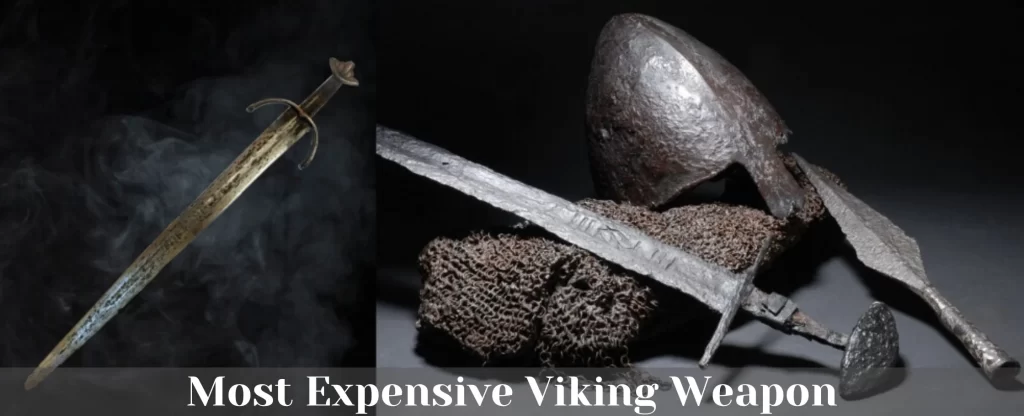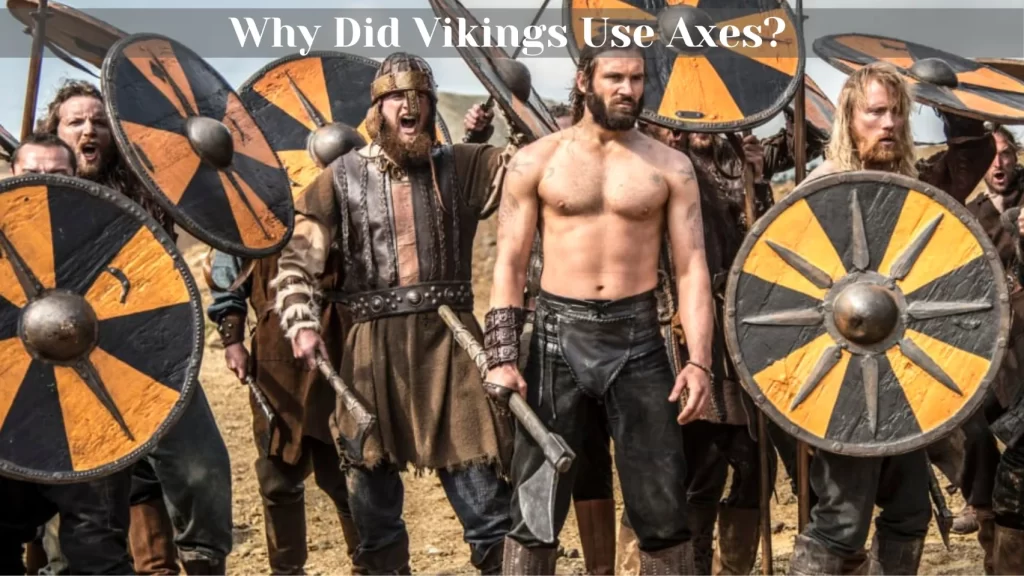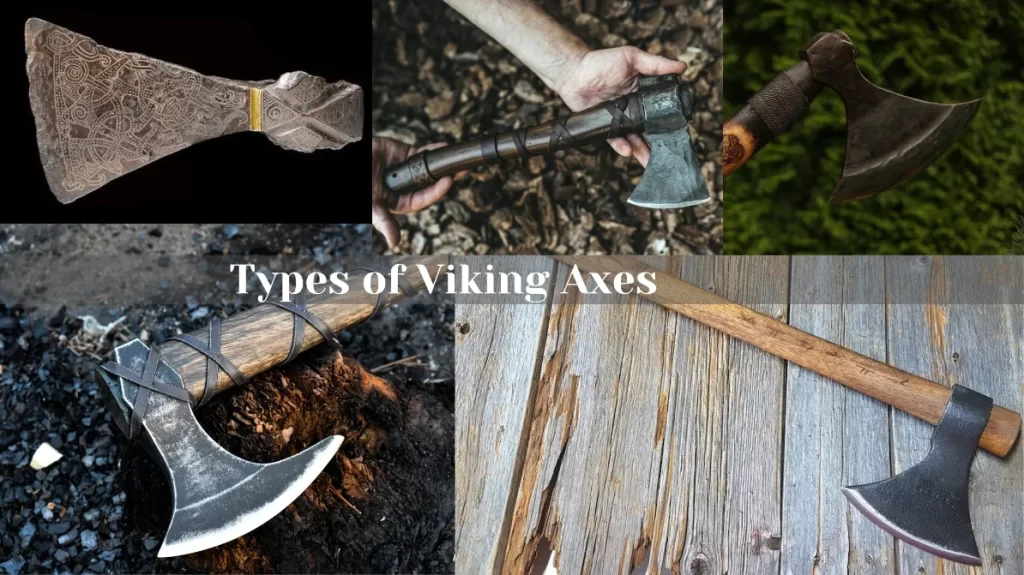
Did you know that a single Viking sword could cost as much as a farm? Imagine stumbling upon an ancient Viking weaponry worths millions of dollars, containing axes, spears, swords, bows, and shields. But do you know what was the most expensive Viking weapon? And if you find out the wealthiest Norse deadly tool, what would you do with it?
The Vikings, renowned for their seafaring prowess and fierce warrior spirit, crafted a diverse arsenal of weapons that reflected their innovations and adaptability. Among this array of tools of war, one stood out for its exceptional quality and astronomical cost – the Ulfberht sword.
In this blog post, we’ll learn about the most valuable Viking weapons. We will also look at the factors that determined the cost and value of weapons.
Contents
The Most Expensive Viking Weapon
Ulfberht swords were the most expensive Viking weapons ever made, and they were also the best. Every Viking would probably dream of owning an Ulfberht sword. They were so rare and legendary that only a few hundred of them have been found, mostly in Scandinavia and around the Baltic Sea.

The Ulfberht sword, named after the blacksmith or workshop that produced it, was a marvel of early medieval metallurgy. This sword was designed using high carbon crucible steel. Its exceptional strength and high carbon content, achieved through a complex pattern-welding technique, set it apart from other Viking swords. These blades were capable of delivering devastating blows, maintaining their sharpness even after prolonged use, and resisting breakage.
Owning an Ulfberht sword was a privilege reserved for the wealthiest and most powerful Vikings. These blades were not merely weapons; they were symbols of status, power, and prowess. Possessing an Ulfberht sword signified a warrior’s skill, wealth, and connection to the highest echelons of Viking society.
Read about the Norse weapons and Viking axe history.
Factors Effecting the Value of Viking Weapons
The exorbitant cost of Viking weapons was not a mere coincidence; it was a consequence of a confluence of factors that transformed these tools of war into prized possessions and symbols of prestige. Let’s delve into the intricacies of production, decoration, and ownership that collectively elevated the value of Viking weaponry.
1. Production and Craftsmanship
The foundation of a valuable Viking weapon lay in the selection of materials. Iron, the primary component, was a scarce and valuable commodity during the Viking Age. Acquiring iron ore and refining it into usable metal was a costly undertaking, adding significantly to the weapon’s worth.
Additionally, the creation of a Viking weapon was not a rapid endeavor. Each step, from forging the blade to shaping the handle and adding intricate details, required patience, precision, and a deep understanding of metallurgy. This time-consuming process further contributed to the weapon’s value, as it reflected the dedication and expertise invested in its creation.
Different types of weapons required different levels of craftsmanship. For example, swords were the most difficult and costly to produce, because they required high-quality steel, which was scarce and imported from faraway lands, and a sophisticated forging process, which involved pattern welding and reverse inlay.
Axes, on the other hand, were easier and cheaper to produce, because they required less steel and a simpler forging process, which involved hammering a single piece of iron into a blade and attaching it to a wooden handle.
Spears were the simplest and cheapest to produce, because they required only a metal head and a wooden shaft, which could be easily made and replaced.
Some examples of the most expensive and valuable weapons in terms of production and craftsmanship are:
The Ulfberht swords, which were made of crucible steel, a superior material that was produced in Central Asia at high temperatures, and had the Ulfberht inscription and a geometric pattern inlaid on their blades using brass or copper.
The Mammen axe, this high carbon iron made weapon had elaborate carvings on both sides of the blade, depicting animals and plants in the Mammen style, a type of Viking art that was influenced by Christian motifs.
The Gokstad spear, which was made of iron and had a long and slender blade with a sharp point and a socket for the shaft, and was found in the Gokstad ship burial, one of the most famous and well-preserved Viking ship burials.
2. Decoration and Symbolism
The decoration and symbolism of weapons also affected their cost and value, because they reflected the aesthetic preferences, cultural beliefs, and personal identities of the owners and makers. The more elaborate and meaningful the decoration, the more costly and valuable the weapons were.
Different types of weapons had different levels of decoration and symbolism. For example, swords were the most decorated and symbolic, because they were considered the most prestigious and personal weapons, and they often had inscriptions, patterns, motifs, and colors that expressed the name, status, affiliation, and faith of the owner or maker.
Axes were less decorated and symbolic, because they were more common and utilitarian weapons, and they usually had simple carvings or engravings that showed the skill or style of the maker. Spears were the least decorated and symbolic, because they were the most basic and disposable weapons, and they rarely had any adornment or meaning beyond their function.
3. Ownership and Inheritance
Not in modern world only, the ancient Norse people also valued the inheritance. The inherited weapons affected their cost and value, because they indicated the social status, wealth, and reputation of the owners and their heirs. The more prestigious and exclusive the ownership, the more costly and valuable the weapons were.
Generally, swords were the most owned and inherited, because they were the most expensive and valuable weapons, and they were often passed down from generation to generation as family heirlooms or gifts of honor.
Axes were less owned and inherited, because they were more affordable and accessible weapons, and they were often traded or sold as commodities or trophies.
Spears were the least owned and inherited, because they were the cheapest and most abundant weapons, and they were often discarded or lost as casualties of war.
Some of the valuable weapons of Vikings that were inherited from generations to generations are:
The Cnut sword, associated with King Cnut the Great, bore the prestige of royalty.
The Eirik Bloodaxe axe, with its storied history, represented the legacy of a king.
The Olaf Tryggvason spear symbolized the grandeur of an influential historical figure.
The Harald Hardrada bow, used by a renowned king, held historical weight.
The Rollo shield, belonging to a legendary Viking, was a mark of his authority.
The Ragnar Lothbrok helmet, associated with the legendary Viking hero, was a symbol of his saga.
The Rurik mail, likely belonging to the Varangian Guard, reflected both its ownership and the cultural exchange between the Vikings and Byzantium.
Conclusion
From the archeologic evidence, historians have found that the Ulfberht sword was the most valuable Viking weapon. It stands out as the pricey and legendary Viking weapon, stands as a symbol of power, prestige, and the enduring legacy of the Viking Age.
The Ulfberht sword was the result of a complex and advanced manufacturing process that was centuries ahead of its time, and it was the most prestigious and personal weapon among the Norse Vikings. Its exceptional strength and high carbon content, achieved through a complex pattern-welding technique, set it apart from other Viking swords.
Frequently Asked Questions
What was the Vikings’ greatest weapon?
The Vikings were skilled in the use of a variety of weapons, but their most effective and feared weapon was the sword. Viking swords were typically double-edged and made from high-quality steel, making them sharp and durable. They were also relatively long, giving Viking warriors a reach advantage over their opponents.
What very expensive weapon was owned by rich Vikings?
One of the most expensive weapons owned by rich Vikings was the Ulfberht sword, which was made of crucible steel, a superior material that was imported from Central Asia. The Ulfberht sword was the result of a complex and advanced manufacturing process that was centuries ahead of its time, and it had the Ulfberht inscription and a geometric pattern inlaid on the blade using brass or copper.
What was the strongest Viking sword?
The Ulfberht sword was also considered to be the strongest Viking sword. Its exceptional strength was due to its high carbon content and pattern-welding technique. Pattern welding involved forging together layers of different types of steel, which created a blade that was both strong and flexible.
Were Viking swords expensive?
Yes, Viking swords were expensive and time consuming to make. They required high-quality steel, which was scarce and imported from faraway lands, and a sophisticated forging process, which involved pattern welding and reverse inlay. Only wealthy and noble warriors could afford to own a sword, and they often passed them down from generation to generation as family heirlooms or gifts of honor.



